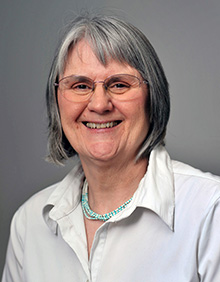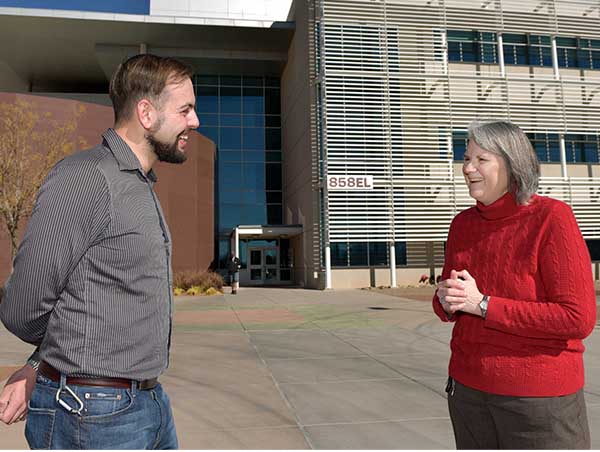Early physics course opened Sandia researcher’s eyes to a world of possibilities
See below: ‘Only one lifelong mentor’
Sandia physicist Danelle Tanner has been named the 2018 Scientist of the Year by the National Organization of Gay and Lesbian Scientists and Technical Professionals. She is the first Labs employee to receive the honor since the NOGLSTP created the award in 2004.
The annual awards were established as a means of identifying, honoring, and documenting the contributions of outstanding LGBTQ+ science, engineering, and technology professionals, as well as the corporations, academic institutions, and businesses that support them. The organization uses the ‘+’ as a way of including everyone who identifies with or supports its diverse community.
Danelle will be presented her award on Feb. 18 in Austin, Texas, at the American Association for the Advancement of Science annual meeting.

From nuclear physics to reliability analysis, and everything in between
Danelle joined Sandia in 1984. Early in her career, she led a team responsible for radiation effects testing of multiple weapons system components at the Nevada Test Site, now the Nevada National Security Site. She also led projects in support of multiple underground nuclear weapon and radiation experiments.
In 1993, she joined the microelectronics reliability group where she delved into reliability physics, redefining her career path. She received funding in 1997 for a three-year Laboratory Directed Research & Development project to establish microelectromechanical systems (MEMS) reliability as a differentiating strength for Sandia in this new developing technology.
“This was at the time of early MEMS devices coming to market, and they were things like accelerometers in Nintendo gaming systems and phones, digital micro-mirror projection systems, and ink jet printers. We wanted to understand overall failure mechanisms to see if MEMS could be used in nuclear weapons,” says Danelle.
She spent the next decade as a leader in MEMS reliability, sharing her knowledge across the United States and Europe, before leading a team responsible for determining the root cause of a particularly challenging electrical component failure. After forcing these parts to fail, the team would work in reverse to determine critical design changes necessary to produce more reliable components.
‘You can do anything you set your mind to’
Danelle grew up the fourth of five children. She always knew she would attend college but didn’t know what she wanted to study. When she began her undergraduate studies in the 1970s, she saw nursing and teaching as the two career paths presented to women and expected she would study the latter.
“My dad would always tell me ‘Danelle, you can do anything you set your mind to,’ and that’s what I did. He was always supportive of me and he was committed to ensuring all of us went to college,” she says.
The first college physics class Danelle took opened her eyes to the possibilities in the field, She says she soon fell in love with science and its ability to explain the world at a fundamental level. The idea of pursuing a career in the field was something Danelle says was outside of her reality at the time — she was in the minority in the field, both as a woman and a lesbian — but she pursued it despite this. She earned a bachelor of science degree in physics and mathematics from the University of Southwestern Louisiana, and a doctorate in nuclear physics from Texas A&M University.
‘I was in the closet for a long time’
Despite a successful, decades-long career, Danelle says she feared her sexual orientation would hold her back. Prior to the 1970s, LGBTQ people were not eligible for federal security clearances and so were denied employment in certain professions. It was not until the 1980s, when Danelle was hired at Sandia, that people were able to disclose their sexual orientation on clearance applications.
“The culture wasn’t like what it is today,” she says. “I was in the closet for a long time. I didn’t come out in the beginning of my career because it was a time when many LGBTQ people were uncomfortable with showing their true selves because of concerns about discrimination.”
It wasn’t until Danelle began dating her now-wife, Wendy, that she began to get comfortable coming out. The two met in 1996 through the Labs’ newly created LGBT employee group, of which both were founding members. With the group’s support, Danelle approached management to discuss equal opportunity employment benefits. Her talks were crucial in securing domestic partner benefits for Sandia employees, ahead of state or federal marriage equality legislation and prior to July 1, 2003, when New Mexico enacted a new anti-discrimination law.
Danelle and Wendy were one of 64 couples legally married during a brief period in 2004 when one New Mexico county clerk began issuing marriage licenses to same-sex couples. The couple has two sons.
“There was a point in my life I would have never thought a recognition like this would be possible,” she says. “A lot of work went into getting here and I am absolutely thrilled to receive this honor.”
‘Only one lifelong mentor’

Robin Jacobs-Gedrim chats with Danelle Tanner, the Sandia researcher who inspired him to pursue a career in science when she visited his second grade classroom more than two decades ago. (Photo by Randy Montoya)
Postdoc Robin Jacobs-Gedrim praises influence of researcher Danelle Tanner
Postdoctoral associate Robin Jacobs-Gedrim still keeps a copy of a letter he wrote nearly 15 years ago when he was a sophomore at Albuquerque’s Valley High School. He had recently been accepted into a Sandia internship program and was placed in microelectronics and MEMS. While seeking out mentors, he came across a familiar name — Danelle Tanner.
“Dear Dr. Tanner, when I was in 2nd grade you came to my classroom to give a talk on basic physics. The lecture sparked my love for the sciences. Later in elementary school, when asked what I wanted to be when I grew up, I would reply ‘a theoretical physicist.’”
Danelle remembered the time fondly. It was 1990 when DOE began funding an educational program at Sandia. The program’s goal was to pair Sandia employees with local schools, where they would serve as science advisors, or SciAds.
Danelle visited Albuquerque’s Alvarado Elementary School one day a week. She spent the first half of the day with the students doing hands-on experiments using science kits provided by Sandia. The idea was to introduce the use of inquiry based on science instruction. In the afternoons, she met with teachers to offer ways they could include more hands-on opportunities during science lessons, like using lasers and magnets or making slime.
The SciAd program ended in 1995 but it had a lasting impact on Robin. In his letter, he explained his upcoming internship would place him in nanotechnology and asked if he could work under her mentorship for the school year. Without hesitation, Danelle agreed.
“How could I not hire him after that letter?” she says. “Each year I would return to the school and bring a different experiment into his classroom. He was always the most responsive and he seemed to absolutely love it. I knew he would make a great addition to my team and I was happy to have him.”
Robin continued to intern at the Labs through his undergraduate studies. The experience, he says, set the bar for his expectations of a professional work environment. He would later attend schools in Florida and New York, but spoke with Danelle often.
“There was a time in which the last place on earth I wanted to live and work my entire life was Albuquerque. I very much wanted to get out an explore the world and my options,” Robin says. “Having experienced other places to live and work I realized Sandia, and Albuquerque, were pretty great.”
The SciAd program, Robin says, is perhaps the reason he is a scientist today, adding that the experience he’s gained over the years stretches far beyond the field of nanotechnology.
“It is incredibly valuable to have a mentor in science who is not directly connected with my present work. I have had many scientific advisors with whom I have worked on specific projects but only one, lifelong scientific mentor — Danelle Tanner.”